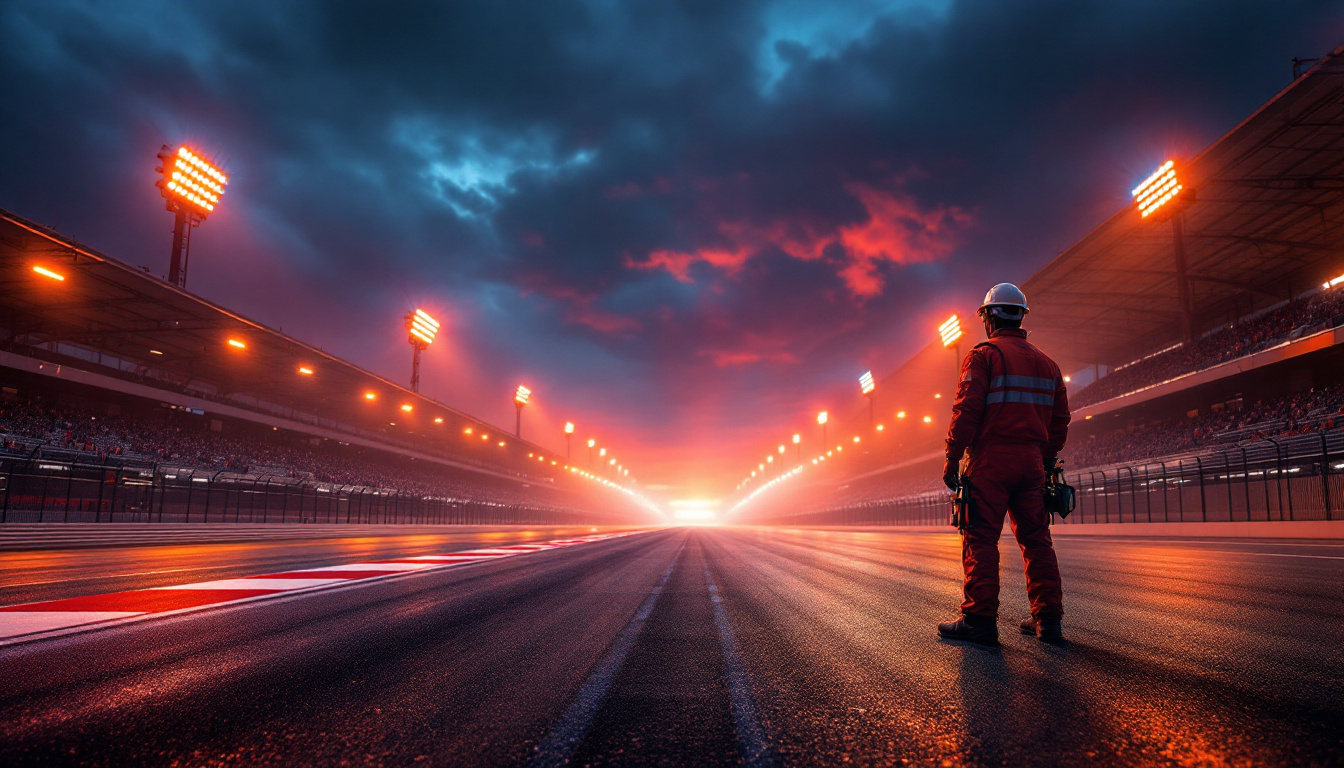
Race track starting lights are essential components in motorsport events, providing a clear visual signal to drivers when the race is about to begin. For lighting contractors, understanding the specifications, functionality, and installation of these lights is crucial for ensuring safety and efficiency at the track. This article will explore the various aspects of race track starting lights, offering insights that will benefit lighting contractors involved in the installation and maintenance of these systems.
Typically, race track starting lights consist of a series of colored lights, often arranged in a vertical or horizontal format, that signal the countdown to the start of the race. The most common configuration includes red, yellow, and green lights, where the red lights indicate that the race is not yet underway, yellow lights signify the final countdown, and the green light signals the start of the race. The precision and timing of these lights are critical; any delays or malfunctions can lead to confusion among drivers and potentially dangerous situations on the track. Therefore, it is imperative for lighting contractors to ensure that these systems are not only installed correctly but also regularly maintained to prevent any operational issues.
Moreover, advancements in technology have led to the development of more sophisticated starting light systems that can incorporate features such as LED lighting for increased visibility and energy efficiency. Some modern systems are even equipped with wireless communication capabilities, allowing for remote operation and monitoring. This innovation enhances the flexibility and responsiveness of race officials, who can adjust the starting lights in real-time based on track conditions or unforeseen circumstances. Understanding these technological advancements is vital for lighting contractors, as it enables them to offer cutting-edge solutions that meet the evolving needs of race tracks and enhance the overall spectator experience.
The primary function of race track starting lights is to indicate the start of a race. These lights are typically positioned at the starting line and are visible to all participants. The sequence of lights changes from red to green, signaling drivers to accelerate. However, the technology and design behind these lights go beyond mere signaling; they also play a vital role in race management.
The standard sequence for race track starting lights includes a series of red lights that illuminate before transitioning to green. This sequence is crucial for ensuring that all drivers have an equal opportunity to react. The timing of these lights can be adjusted based on the type of race and the specific regulations governing it. Understanding the timing mechanisms is essential for contractors who need to install or repair these systems. Additionally, the precision of the timing can significantly impact race outcomes, as even a fraction of a second can alter the dynamics of a race. In many professional racing leagues, the starting lights are synchronized with electronic timing systems that track each vehicle’s performance, ensuring fairness and accuracy in the competition.
There are various types of starting lights available, each designed for specific applications. Traditional incandescent lights, LED lights, and even advanced digital displays are options that contractors may encounter. LED lights, for instance, are becoming increasingly popular due to their energy efficiency and longevity. Contractors should be familiar with the advantages and disadvantages of each type to make informed recommendations to their clients. Furthermore, some modern starting light systems incorporate additional features such as integrated sensors that can detect false starts, automatically triggering penalties for drivers who jump the gun. This technology not only enhances the integrity of the race but also provides a more engaging experience for spectators, who can witness the precision and fairness of the competition unfold in real-time.
When selecting race track starting lights, several key features should be taken into account. These features not only impact the performance of the lights but also influence the overall safety of the racing environment.
Visibility is paramount in a racing environment. Starting lights must be bright enough to be seen in various weather conditions and from a distance. Contractors should evaluate the lumen output and the angle of visibility when selecting lights for a specific track. Additionally, the color of the lights should comply with racing regulations to ensure clarity for drivers.
Race tracks are often exposed to harsh weather conditions, making durability a critical factor. Starting lights should be constructed from materials that can withstand rain, snow, and extreme temperatures. Contractors should look for lights that have an IP (Ingress Protection) rating, which indicates their resistance to dust and water ingress.
Modern race track starting lights often come equipped with sophisticated control systems that allow for precise timing and synchronization with other race management tools. Understanding how these control systems work is essential for contractors, as they may need to integrate the lights with existing track infrastructure. Familiarity with both manual and automated control systems will enhance a contractor’s ability to deliver a comprehensive solution.
Proper installation of race track starting lights is crucial for their functionality and longevity. Lighting contractors must be aware of several factors that can impact the installation process.
Before installation, a thorough site assessment should be conducted. This includes evaluating the track layout, determining the best locations for the lights, and considering the visibility from various angles. A well-planned installation will ensure that the lights serve their purpose effectively and enhance the overall racing experience.
Race track starting lights require a reliable electrical supply. Contractors must ensure that the electrical infrastructure can support the lights’ power demands. This includes assessing the voltage requirements and ensuring that all wiring is properly rated for outdoor use. Additionally, contractors should consider backup power solutions to maintain functionality in case of a power failure.
Compliance with local and national regulations is a non-negotiable aspect of any installation project. Contractors should familiarize themselves with the relevant standards governing race track lighting. This may include safety standards, electrical codes, and specific regulations set forth by racing organizations. Ensuring compliance will not only enhance safety but also protect contractors from potential liabilities.
Once installed, race track starting lights require regular maintenance to ensure they remain operational. Understanding the common issues that can arise and how to troubleshoot them is vital for lighting contractors.
Regular inspections can help identify potential problems before they escalate. Contractors should establish a maintenance schedule that includes checking the functionality of the lights, inspecting wiring and connections, and cleaning the fixtures to remove any debris that may obstruct visibility. Keeping detailed records of inspections can also aid in tracking the performance of the lighting system over time.
Some common issues with race track starting lights include flickering, failure to illuminate, and color inconsistencies. Understanding the root causes of these problems can help contractors implement effective solutions. For instance, flickering lights may indicate a loose connection, while color inconsistencies could be a sign of aging bulbs. Having a toolkit and spare parts readily available can expedite the troubleshooting process.
As technology advances, upgrading existing race track lighting systems may become necessary. Contractors should stay informed about the latest innovations in lighting technology, such as smart lighting systems that can be controlled remotely. Upgrading can enhance performance, improve energy efficiency, and provide better visibility for drivers.
Cost is always a significant factor in any lighting project. Understanding the various costs associated with race track starting lights can help contractors provide accurate estimates to their clients.
The initial investment for race track starting lights can vary widely based on the type of lights chosen, the complexity of the installation, and any additional features required. Contractors should conduct a cost analysis that includes not only the price of the lights but also installation labor and any necessary electrical upgrades.
While the initial investment may be substantial, it is essential to consider the long-term savings associated with energy-efficient lighting options. LED lights, for example, may have a higher upfront cost but can significantly reduce energy consumption and maintenance costs over time. Contractors should communicate these long-term benefits to clients to justify the initial expenditure.
Race track starting lights play a vital role in the safety and efficiency of motorsport events. For lighting contractors, understanding the functionality, installation, and maintenance of these lights is crucial for delivering high-quality services. By considering factors such as visibility, durability, and compliance with regulations, contractors can ensure that they provide reliable lighting solutions that enhance the racing experience.
As technology continues to evolve, staying informed about the latest advancements in race track lighting will enable contractors to offer the best solutions to their clients. Whether it’s through routine maintenance, troubleshooting common issues, or upgrading systems, the expertise of lighting contractors is essential in keeping race track starting lights operational and effective.
In summary, investing time to understand race track starting lights will not only benefit contractors but also contribute to the overall safety and enjoyment of motorsport events. With the right knowledge and skills, lighting contractors can excel in this niche market.
Ready to illuminate the track with the highest quality starting lights? Look no further than LumenWholesale, where we provide lighting contractors with spec-grade lighting products at unbeatable wholesale prices. Our selection of race track starting lights meets the highest industry standards, ensuring peak performance and reliability for every race event. Take advantage of our hassle-free bulk buying options with free shipping and no hidden fees. Elevate your lighting game and give your clients the best value by choosing Wholesale Lighting at the Best Value with LumenWholesale.
Discover how LED retrofit kits are transforming the lighting industry and boosting profits for contractors.

Discover how Keystone Products is revolutionizing the lighting industry with innovative designs and seamless installation solutions.

Discover the essential insights lighting contractors need about solar floodlights.

Discover the essentials of LED magnetic strip retrofit kits and why they’re a game-changer for lighting contractors.